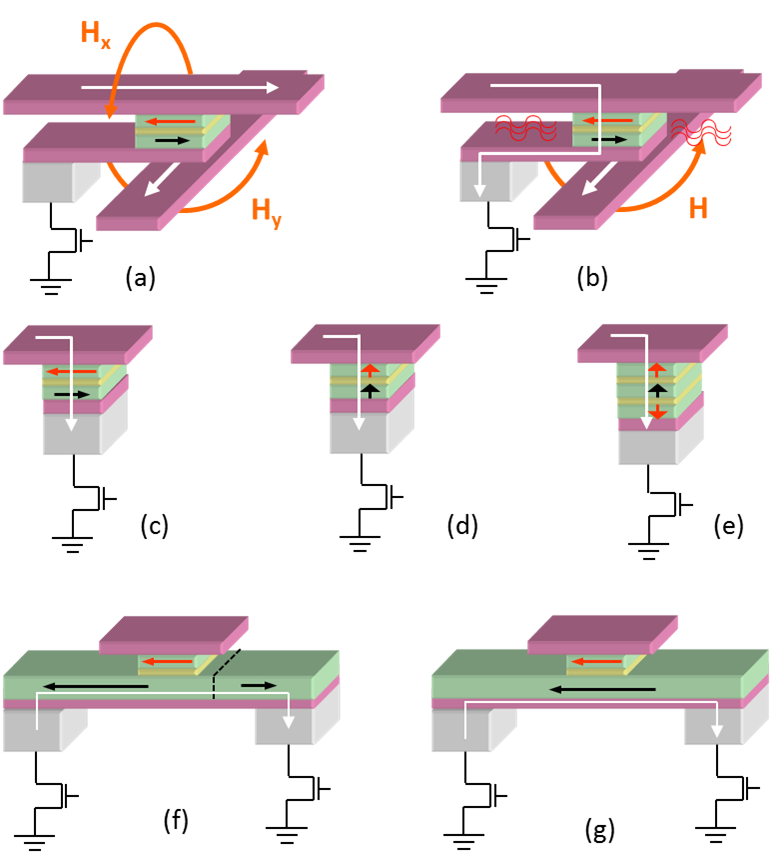Thematic overview
Magnetic Random Access Memories (MRAM) is a non-volatile memory technology, where information is stored by the magnetization direction of magnetic electrodes, very similar to computer hard-disk drives. The goal for MRAM memory is to simultaneously achieve high-speed read/write times, high density and unlimited cycling compared to other existing and emerging technologies.
Our group is developing advanced MRAM cell concepts patented at Spintec. The concepts are based on the use of temperature to reduce power consumption and increase the stability of the stored information. These ideas go beyond the conventional MRAM approach. The naturally occurring temperature increase during the write step is not lost, but is instead used to achieve the seemingly opposing goal of lowering the power consumption and increasing the thermal stability in the operating temperature range. Our group fosters young and experienced researchers developing/applying their expertise in the field of MRAM.

Questions to be addressed
Our main research axis is to use the naturally occurring temperature increase during the write step, when a current flows through the magnetic tunnel junction. The heating is used to go above a temperature threshold, making it possible to write the storage layer magnetization. This principle has been applied to in-plane magnetization cells using a storage layer pinned by an anti-ferromagnet and recently to perpendicular anisotropy cells. Our group’s goal is to demonstrate the proof-of-concept and then improve MRAM cell properties.
Our work involves the development of magnetic material systems, nano-fabrication (20-200nm cells), characterization of devices (magnetic & electrical) and simulation of the device behavior. Our activity in these vast fields is as follows;: On materials research, we are developing magnetic tunnel junctions with in-plane and perpendicular magnetic anisotropy. New electrode stacks having the material properties required by each specific concept need to be integrated in magnetic tunnel junctions, while achieving high levels of TMR signal. For the characterization of each concept we determine the write window parameters in terms of magnetic field, power consumption and magnetization reversal dynamics. Macrospin and micromagnetic simulation provide a better physical understanding of the system properties and the possibilities for optimization.
Projects
ANR EXCALYB – Perpendicular Anisotropy Materials for High-Density Non-volatile Magnetic Memory Cells
Crocus R&D – Thermally assisted MRAM
Samsung SGMI
Partners
Crocus Technology
Institut Néel
SP2M/NM
SAMSUNG
Applied Materials
SINGULUS
Recent news
- GREAT – A H2020 ICT project at SPINTEC [June 30th, 2016]
Overview GREAT (European H2020 project) was accepted at the Summer 2015. Its kick-off meeting took place at SPINTEC in Grenoble on February 22nd-23rd 2016. The project aims at developing magnetic stacks able to equally perform memory, radio-frequency ... - SPICE – An H2020 FET project at SPINTEC [May 19th, 2016]
A new research project has been accepted at the last FET H2020 call. The objective of SPICE is to realize a novel integration platform that combines photonic, magnetic and electronic components. Its validity will be shown ... - Soutenance de thèse – Antoine CHAVENT [January 15th, 2016]
Jeudi 21 Janvier 2016 à 14H00, Phelma MINATEC – Amphithéâtre M001 (3 Parvis Louis Néel – 38016 Grenoble) Monsieur Antoine CHAVENT du DSM/INAC/SPINTEC soutiendra une thèse intitulée « Réduction du champ d’écriture de mémoires magnétiques à écriture assistée thermiquement ... - Improving writing properties of TAS-MRAM by changing the voltage pulse shape [January 11th, 2016]
During writing of Thermally Assisted Switching Magnetic Random Access Memory (TAS-MRAM), the torque due to a voltage pulse may be used to help writing. As part of collaboration between Spintec and Crocus Technology, we brought ... - Une mémoire STT MRAM sub-nanoseconde made in Spintec [December 09th, 2015]
Spintec développe une mémoire STT-MRAM dix fois plus rapide que les produits annoncés pour 2016 chez Samsung ou Intel. Sa vitesse d’écriture est inférieure à la nanoseconde, contre 5 à 10 nanosecondes habituellement. La différence ...

SOUSA Ricardo
ricardo.sousa@cea.fr

BALTZ Vincent
vincent.baltz@cea.fr

PREJBEANU Lucian
lucian.prejbeanu@cea.fr

DIENY Bernard
bernard.dieny@cea.fr





